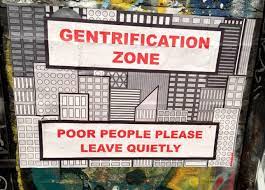
Get rid of the working-class neighborhood, embrace gentrification now
Citaat Aristoteles: “Armoede is de vader van revolutie en misdaad”.
Quoting Aristotle: “Poverty is the father of revolution and crime.”
Apetrots, dat NRC mijn opstel in de zomerrubriek Anderzijds heeft geplaatst. De strekking van het verhaal: “Gentrificatie is nodig om oude wijken minder afhankelijk te maken. Maar jaag niet alle sociale huurders weg.”
https://www.nrc.nl/nieuws/2023/09/01/weg-met-de-volkswijk-omarm-gentrificatie-a4173300?t=1695939953
In NRC hebben veel artikelen gestaan over de voor- en nadelen van gentrificatie, de opwaardering of ‘upgrade’ van een oude buurt in een stad met als doel rijkere bewoners aan te trekken. Dat voor lagere inkomens dan geen plaats meer is omdat huren en huizenprijzen stijgen wordt gezien als belangrijkste negatieve effect. Amsterdam (eerst de Jordaan, nu zelfs Noord) en zeker ook Rotterdam maken als gevolg van heftige gentrificatie metamorfoses door. De verpauperde volkswijken worden opgeknapt, waardoor de leefbaarheid in die wijken wordt genormaliseerd. Andere grote steden als Den Haag en Utrecht, maar ook Eindhoven (‘brainport’) timmeren al flink aan de gentrificatieweg.
Het sentiment hierover lijkt over te hellen naar verzet tegen de verdrijving van de oorspronkelijke wijkbewoners door de aanwassende vloedgolf van yuppen. En dus naar het stoppen van gentrificatie. Dat is jammer. Maar wellicht is dit een goede aanleiding om te kijken of gentrificatie op een andere manier moet worden ingevuld.
Gemeenten komen op voor hun burgers. Maar vooral voor die in de volkswijken waarvan de bewoners sterk afhankelijk zijn van de financiële steun van de overheid. En die die afhankelijkheid doorgeven aan de volgende generaties. De verpaupering is bij de jeugd vaak een goede voedingsbodem voor (drugs)criminaliteit. Om uit die neerwaartse spiraal te komen moet die onlesbare geldbehoefte van een wijk stoppen. Dat kan alleen als de wijkbewoner financieel op eigen benen kan staan, niet dankzij criminaliteit.
Het is zo bezien niet onlogisch om de volkswijk aantrekkelijk te maken voor vooral jonge één- of tweeverdieners die veel te spenderen hebben. Hun jonge leeftijd garandeert een langdurig verblijf in de wijk, niet het minst door mogelijke gezinsvorming. Dat betekent een investering in voorzieningen (zoals huisvesting, school, zorg).
Gentrificatie is dus nodig voor stadsontwikkeling. Investeringen door de overheid kennen een grens die voor beleggers niet geldt, zolang er maar een goed rendement is. De voorgenomen maatregelen om het rendement voor particuliere beleggers af te toppen helpen dus niet.
Gecharmeerd van de volkswijk
De overheid zou met het oog op gentrificatie juist regulerend kunnen optreden door bijvoorbeeld een vast deel van het vastgoed voor sociale huurders (de oorspronkelijke wijkbewoners) te bestemmen, in ruil voor behoud van het belastingvrije rendement. Mogelijk in samenhang met een voorgenomen herziening van het toeslagensysteem. Door deze mix van wijkbewoners met verschillende kapitaalkracht zou de kritiek op de verdrijving van niet kapitaalkrachtige bewoners kunnen worden tegengegaan.
Maar niet alleen daarvoor is deze mix belangrijk. Gebleken is dat financieel gelijkgestemden in hun sociale bubbel blijven. Niet omdat zij niet buiten hun bubbel willen komen, maar omdat de ratrace van de (werk)dag dat niet toelaat. Immers: druk-druk-druk. Maar de kapitaalkrachtige nieuwkomer in de volkswijk is wel gecharmeerd van het typische karakter van de volkswijk: onderling zorgzaam, sociaal verbonden en hulpvaardig. Althans, het beeld ervan.
Aan de andere kant zien de oorspronkelijke bewoners, dat hun wijk wordt opgeknapt en overlast verdwijnt. Een win-win situatie. Gentrificatie heeft alleen kans van slagen, in die zin dat de volkswijk met behoud van haar karakter uit haar verpaupering ontsnapt, als oud- en nieuwkomers met elkaar door één deur willen gaan. Omdat bij beiden die wil aanwezig is is het aan de gemeente om die contact/ontmoetingsmomenten te faciliteren. Dus niet alleen weg met de volkswijk, maar omarm en faciliteer deze door gentrificatie.
Very proud that NRC has placed my essay in the summer section On the Other Side. The gist of the story: “Gentrification is necessary to make old neighborhoods less dependent. But don’t chase away all social tenants.”
NRC has contained many articles about the pros and cons of gentrification, the upgrading or ‘upgrade’ of an old neighborhood in a city with the aim of attracting wealthier residents. The fact that there is no longer room for lower incomes because rents and house prices rise is seen as the most important negative effect. Amsterdam (first the Jordaan, now even North) and certainly Rotterdam are undergoing metamorphoses as a result of intense gentrification. The impoverished working-class neighborhoods are being renovated, normalizing the quality of life in those neighborhoods. Other major cities such as The Hague and Utrecht, but also Eindhoven (‘brainport’) are already working hard on the gentrification road.
The sentiment about this seems to be leaning towards resistance against the expulsion of the original residents of the neighborhood by the rising tide of yuppies. And so to stopping gentrification. That’s too bad. But perhaps this is a good reason to see whether gentrification should be implemented in a different way.
Municipalities stand up for their citizens. But especially for those in working-class neighborhoods whose residents are highly dependent on government financial support. And who pass on that dependency to the next generations. Impoverishment among youth is often a good breeding ground for (drug) crime. To get out of that downward spiral, a neighborhood’s unquenchable need for money must stop. This is only possible if the local resident can stand on his own two feet financially, not thanks to crime.
Seen in this light, it is not illogical to make the working-class neighborhood attractive, especially for young one- or two-income households who have a lot to spend. Their young age guarantees a long-term stay in the neighborhood, not least because of possible family formation. This means an investment in facilities (such as housing, school, healthcare).
Gentrification is therefore necessary for urban development. Government investments have limits that do not apply to investors, as long as there is a good return. The proposed measures to cap returns for private investors therefore do not help.
Charmed by the working-class district
With a view to gentrification, the government could take regulatory action by, for example, earmarking a fixed part of the real estate for social tenants (the original neighborhood residents), in exchange for maintaining the tax-free return. Possibly in connection with a proposed revision of the benefits system. This mix of neighborhood residents with different capital strength could counter the criticism of the expulsion of residents who are not wealthy.
But this mix is not only important for that. It has been found that financially like-minded people remain in their social bubble. Not because they do not want to leave their bubble, but because the rat race of the (work) day does not allow that. After all: busy-busy-busy. But the wealthy newcomer to the working-class neighborhood is charmed by the typical character of the working-class neighborhood: mutually caring, socially connected and helpful. At least, the image of it.
On the other hand, the original residents see that their neighborhood is being renovated and nuisances are disappearing. A win-win situation. Gentrification only has a chance of success, in the sense that the working-class neighborhood will escape its impoverishment while retaining its character, if old and newcomers want to go through the same door together. Because both people have that will, it is up to the municipality to facilitate those contact/meeting moments. So don’t just get rid of the working-class neighborhood, but embrace and facilitate it through gentrification.
Ricky Turpijn



